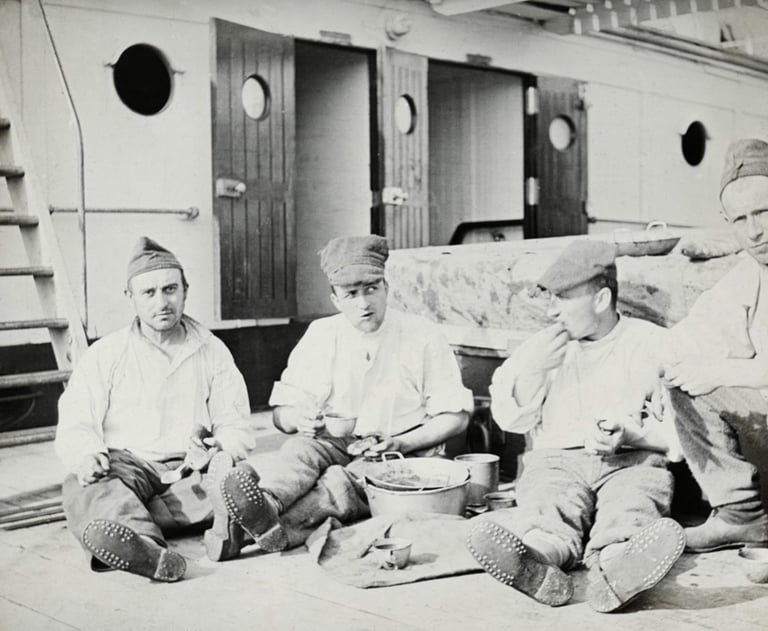Meals
11/4/20242 min read


Léon Collin, Convicts eating on deck a transport bound for French Guiana, 1906-1910, Musée Nicéphore Niépce de Châlon-sur-Saônes.
We have a significant number of ration lists, but there is still a great deal that we don’t understand about the meals on convict ships. Three or four mornings a week, breakfast consisted of boiled wheat or rice, or from 1792, oatmeal sweetened with sugar or molasses and moistened with butter.
But it is unknown what they had on other days – possibly a cup of tea with sea biscuit. From 1789, the women were supplied with tea and sugar as part of their rations, and while the men were not routinely issued with these articles until the 1830s, many of them brought their own tea on board from the earliest years (see Catspaw ‘Tea on the Lady Juliana’).
Dinner, the main meal of the day, consisted of salted beef or pork, alternating with meat-free banyan days, when they would be given pease and rice, and after 1792, dried fish – a diet that was based on naval rations. From 1792, suet pudding with raisins or plums was also issued to the convicts three days a week. And while the ships were in port, they would be served most days with fresh meat and vegetables to assist in recovering from scurvy, as well as soft bread.
Much less is known about supper. It was probably not a prepared meal, and it seems likely that they snacked on biscuit and cheese, and possibly cold meat. On some of the later convict voyages, there is reference to burgoo (oatmeal porridge) being cooked for supper, supplemented with cocoa (although many of the Irish had an intense dislike of chocolate and refused it).
There was not a great deal of variety in this diet, and as the voyage progressed, the officers and gentlemen would also be reduced to eating ‘salt beef and creeping biscuit’. But seamen and passengers usually brought food of their own and condiments to spice up their meals, and undoubtedly some of the convicts did the same. The convict rations were not rich in nutritional value - that was unavoidable given the preservation technologies available at the time; in calorific terms, however, the prisoners ate well, in many cases, better than family and friends at home.
Seamen ate with their hands or brought their own eating utensils, and this may have been the government’s intention with the First Fleet, where each convict mess was supplied with nothing more than a bowl for their food and a keg for their daily ration of water.
Frying pans and tea kettles, and knives, forks and spoons were brought on board the Neptune (1790) by the convicts, but they were confiscated, out of a concern that they might be used to produce files and saws for mutiny or escape. Thereafter, it seems that knives were issued to mess captains at dinner time and collected at the end of the meal.
On some ships, the convicts were permitted to have their own pots and dishes, and from 1798, the government issued each prisoner with a half pint pot, a bowl and a spoon, and each mess with a six-gallon keg, a large round tin, a small tin kettle, a bread bag and a pudding bag.
The convicts ate in their own quarters, seated on the floor around a common mess bowl, since there were no tables. In this regard, they were no different to the seamen, who usually ate like this in the forecastle. Whilst in the tropics, the women were sometimes allowed to dine on the upper deck under the awnings.
Contact us
Connect with us
Botany Baymen acknowledges the traditional custodians of country throughout Australia and respects their connection to land, water and community.
© Botany Baymen 2024. All rights reserved.
You may download, display, print and reproduce this content for your personal or non-commercial use but only in an unaltered form and with the copyright acknowledged.

